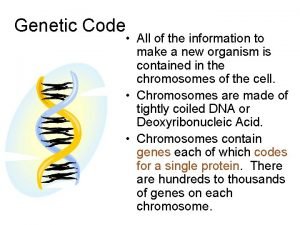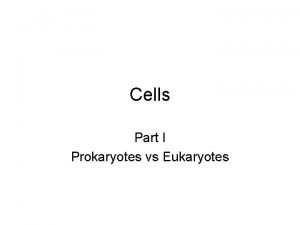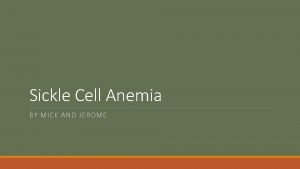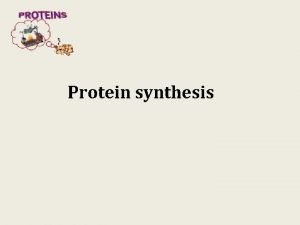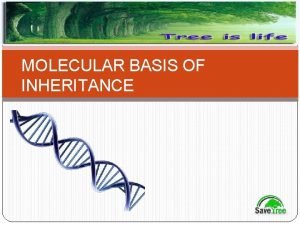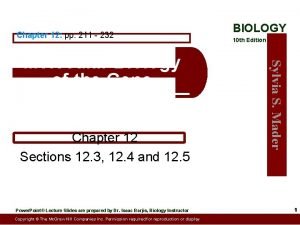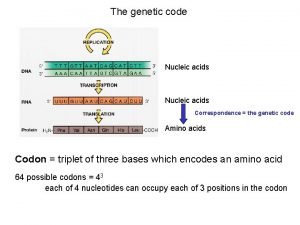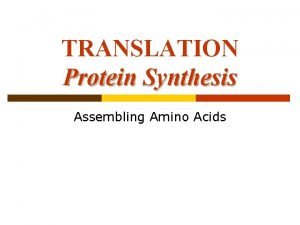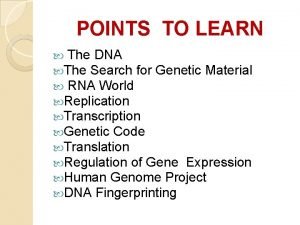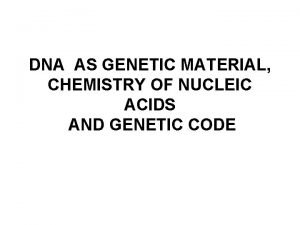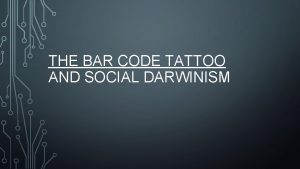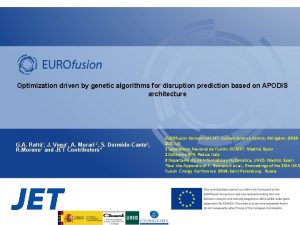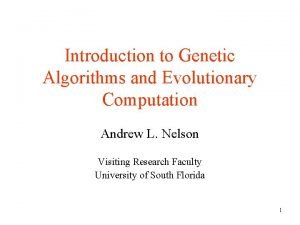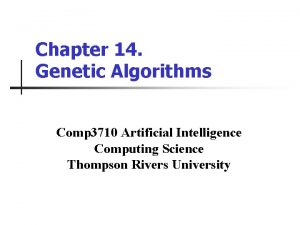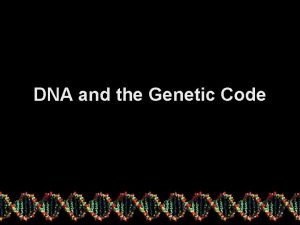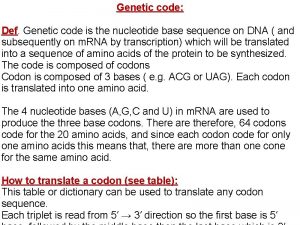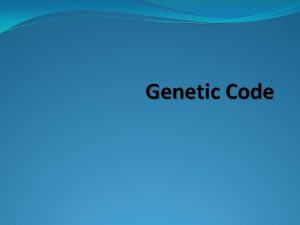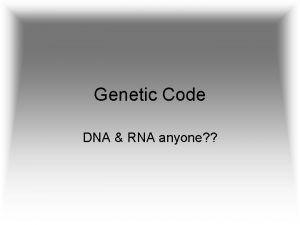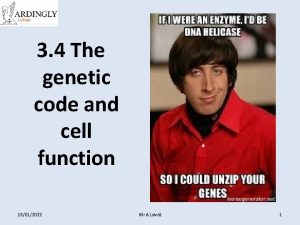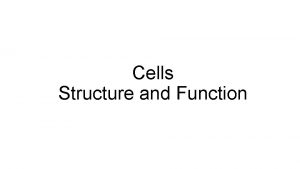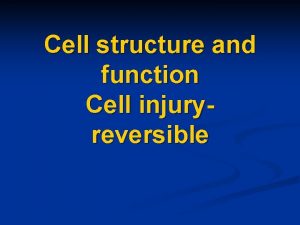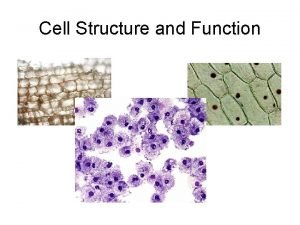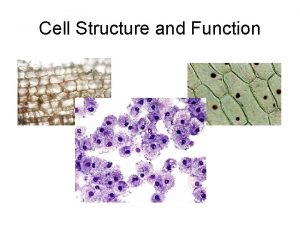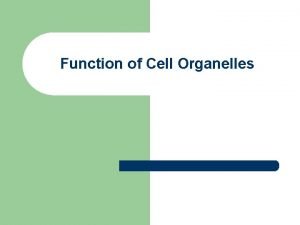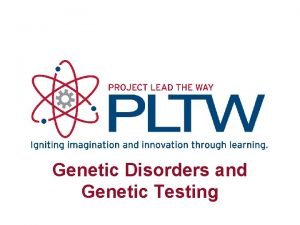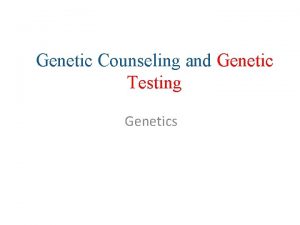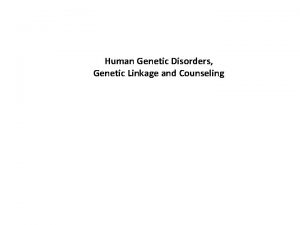The genetic code and cell function 05122020 Mr







































































- Slides: 71

The genetic code and cell function 05/12/2020 Mr A Lovat 1

• http: //genome. pfizer. com/zipunzip. cfm

You should be able to… ● Know the structure of DNA, including the structure of the nucleotides (purines and pyrimidines), base pairing, the two sugar-phosphate backbones, phosphodiester bonds and hydrogen bonds. ● Understand how DNA is replicated semi-conservatively, including the role of DNA helicase, polymerase and ligase. ● Know that a gene is a sequence of bases on a DNA molecule coding for a sequence of amino acids in a polypeptide chain. ● Know the structure of m. RNA including nucleotides, the sugar phosphate backbone and the role of hydrogen bonds. ● Know the structure of t. RNA, including nucleotides, the role of hydrogen bonds and the anticodon. ● Understand the processes of transcription in the nucleus and translation at the ribosome, including the role of sense and anti-sense DNA, m. RNA, t. RNA and the ribosomes. ● Understand the nature of the genetic code, including triplets coding for amino acids, start and stop codons, degenerate and non-overlapping nature, and that not all the genome codes for proteins. ● Understand the term gene mutation as illustrated by base deletions, insertions and substitutions. Understand the effect of point mutations on amino acid sequences, as illustrated by sickle cell anaemia in humans.

Semi-Conservative Model

Two theories existed. . . Conservative Hypothesis �The complete parent DNA molecule acts as a template for the new daughter molecule, which is assembled from new nucleotides. The parent molecule is unchanged. Semi-conservative Hypothesis �The parent DNA molecule separates into its two component strands, each of which acts as a template for the formation of a new complementary strand. The two daughter molecules therefore contain half the parent DNA and half new DNA (semi-conservative hypothesis).

2 models

• http: //www. learnerstv. com/animation/biolog y/con 20 ani. swf

DNA helicase unzips the 2 strands The enzymes breaks the hydrogen bonds holding the base pairs together.

Free Nucleotides Bind Complementary base pairing • DNA helicase completes the splitting of the strand. • Meanwhile, free nucleotides that have been activated are attracted to their complementary bases. • Each chain acts as a template.

DNA Polymerase • Once in placed the activated nucleotides are joined together by DNA polymerase. • DNA polymerase joins the new nucleotides to each other by strong covalent bonds, forming the phosphate-sugar backbone.

Replication Finished �The result is that there are two DNA molecules, each with one new synthesised strand of DNA and one strand from the original. �The DNA is then rewound by another enzyme.

A winding enzyme winds the new strands up to form double helices. DNA helicase unwinds and unzips DNA, breaking the hydrogen bonds that join the base pairs, and forming two separate strands. DNA polymerase joins the new nucleotides to each other by strong covalent bonds, forming the phosphate-sugar backbone. Replication starts at a specific sequence on the DNA molecule. The new DNA is built up from the four nucleotides (A, C, G and T) that are abundant in the nucleoplasm. The two new molecules are identical to the old molecule. These nucleotides attach themselves to the bases on the old strands by complementary base pairing. Where there is a T base, only an A nucleotide will bind, and so on.

Steps of Replication 1. 2. 3. 4. 5. 6. 7. Replication starts at a specific sequence on the DNA molecule. DNA helicase unwinds and unzips DNA, breaking the hydrogen bonds that join the base pairs, and forming two separate strands. The new DNA is built up from the four nucleotides (A, C, G and T) that are abundant in the nucleoplasm. These nucleotides attach themselves to the bases on the old strands by complementary base pairing. Where there is a T base, only an A nucleotide will bind, and so on. DNA polymerase joins the new nucleotides to each other by strong covalent bonds, forming the phosphate-sugar backbone. A winding enzyme winds the new strands up to form double helices. The two new molecules are identical to the old molecule.

• http: //www. youtube. com/watch? v=bee 6 PWU g. Po 8&feature=player_embedded • 05/12/2020 Mr A Lovat 14

Explain how the base sequence of DNA is conserved during replication. 5 marks 05/12/2020 Mr A Lovat 15

DNA replication is semi-conservative; DNA is split into two single/template strands; nucleotides are assembled on/attached to each single/template strand; by complementary base pairing; adenine with thymine and cytosine with guanine / A with T and C with G; strand newly formed on each template strand is identical to other template strand; DNA polymerase used; Marks may be awarded for any of the above points if clearly presented in a well-annotated diagram. 5 max 05/12/2020 Mr A Lovat 16

DNA replication summary http: //www. stolaf. edu/people/giannin i/flashanimat/molgenetics/dnarna 2. swf 05/12/2020 Mr A Lovat 17

DNA – true or false?

• http: //www. nobelprize. org/educational/medi cine/dna_double_helix/dnahelix. html

05/12/2020 Mr A Lovat 20

RNA • RNA = ribonucleic acid • RNA is a single -stranded polymer • Each RNA nucleotide consists of: – A pentose sugar (ribose) – A phosphate group – A base – adenine, cytosine, guanine, uracil (instead of thymine) • RNA used in protein synthesis is messenger RNA (m. RNA) or transfer RNA (t. RNA).

RNA contains the pentose sugar ribose. DNA contains the pentose sugar deoxyribose.

Messenger RNA (m. RNA) • m. RNA is used to transfer the DNA code from the nucleus to the cytoplasm. • m. RNA is complementary to the DNA code. • m. RNA is small enough to leave the nuclear pores. • Once in the cytoplasm, m. RNA associates with the ribosomes. • m. RNA is used to determine the sequence of amino acids during protein synthesis. • m. RNA is easily broken down and only exists whilst it is needed to manufacture a protein. • The sequence of nucleotides in the m. RNA is referred to as the genetic code.

Transcription (forming m. RNA)

Transfer RNA (t. RNA) • t. RNA is a small molecule (~80 nucleotides). • Single stranded and folded into a clover leaf shape with one end of the chain slightly longer. • This longer section is attached to an amino acid. • Each t. RNA can carry a different amino acid. • 3 bases at the opposite end of the t. RNA are called an anticodon. • Each amino acid has a different anticodon. • The anticodon pairs with the complementary codon on the m. RNA.

Amino acid joins here Anticodon

Comparison of DNA, m. RNA and t. RNA Feature Double/Single Size Shape Sugar Bases Quantity in cells Stability DNA m. RNA t. RNA

Comparison of DNA, m. RNA and t. RNA Feature DNA m. RNA t. RNA Double/Single Double Single Size Largest Variable Smaller Shape Double helix Single helix Clover shape Sugar Deoxyribose Ribose Bases A, G, T, C A, G, U, C Quantity in cells Constant (gametes) Varies Stability Very stable Unstable More stable than m. RNA, less than DNA

29

http: //education. cambridge. org/uk/whatsnew/blog/posts/2014/08/epigenetics-how-dna -methylation-can-change-your-genes http: //www. newscientist. com/article/mg 2082 7853. 500 -genes-marked-by-stress-makegrandchildren-mentallyill. html? full=true&print=true#. VG 85 DGdy. Y 3 E 30

05/12/2020 Mr A Lovat 31

TRANSCRIPTION The process by which DNA is ‘read’ to produce a strand of m. RNA polymerase 5’ Sense Strand A G T C A A T G C T A T G C A T T C C G T A C T C A G T T A C G A T A C G T A A G G C A T G A G U C A A U Anti-sense Strand G C U A U G C A U U C C G U A C 3’ 5’ 3’ DNA 5’ m. RNA 3’

Transcription • Helicase (enzyme) acts on a region of DNA to break the hydrogen bonds between the bases. • RNA polymerase moves along one of the two DNA strands – template strand • RNA polymerase matches up complementary RNA nucleotides. • C matches G and G matches C U matches A and A matches T • As the RNA nucleotides join together the pre-m. RNA is formed. • The DNA behind the RNA polymerase rejoins into a double helix. • When the RNA polymerase reaches a “stop” codon, the chain is terminated and the pre-m. RNA detaches.

Animations http: //www. stolaf. edu • http: //highered. mcg /people/giannini/flas rawhanimat/molgenetic hill. com/olcweb/cgi/ s/transcription. swf pluginpop. cgi? it=swf : : 525: : 530: : /sites/dl/ free/0072464631/29 http: //www. johnkyrk. c 1136/m. RNA_synthes om/DNAtranscriptio is. swf: : m. RNA_synthe n. html sis. swf 34

Fun fact of the day… • Introns figured prominently in Star Trek: The Next Generation, Season 7, Episode 271, entitled "Genesis. " • https: //www. youtube. com/watch? v=ork 5 m 37 Nhnk • In this episode, a synthetic T-cell inadvertently activated the crewmembers' introns, resulting in deevolution and the expression of ancient physiological traits

Splicing of m. RNA to form m. RNA • Once the introns (non-functional DNA) have been removed, the remaining exon sections join together.

RNA Splicing Spliceosome sn. RNPs

Transcription Animation m. RNA splicing http: //highered. mcgrawhill. com/olcweb/cgi/pluginpop. cgi? it=swf: : 525: : 530: : /sites/dl/free/007 2464631/291136/spliceosomes. swf: : spliceosomes. swf http: //bcs. whfreeman. com/thelifewire/content/chp 14/1401 s. swf

Polypeptide synthesis – translation You should be able to… • 3. 5. 3 Describe the genetic code in terms of codons composed of triplets of bases. • 3. 5. 4 Explain the process of translation, leading to polypeptide formation. • 3. 5. 5 Discuss the relationship between one gene and one polypeptide.

TRANSLATION Remember our strand of m. RNA from before? SER ALA U C A G C A VAL G U U THR A C G ILE ARG A U A C G U LYS A A G ALA G C A SER U G C A G U C A A U G C U A U G C A U U C C G U A C G

Synthesising the polypeptide (translation) • m. RNA attaches to the ribosome at the “start” codon – AUG. • t. RNA with a complementary anticodon attaches to the m. RNA – UAC. • This t. RNA is attached to an amino acid – methionine • The ribosome moves along the m. RNA bringing in 2 t. RNA molecules at any one time. • An enzyme and ATP are used to join the amino acids with a peptide bond. • The first t. RNA is released and can collect another amino acid. • The process is repeated until a “stop” codon is reached. • Many ribosomes can travel along the m. RNA at the same time – polysome.


CCCGGATATCCGTATGGAATACTCTCTTCT

DNA and the Genetic Code What does the code actually do?

Reminder of DNA Structure • Double-helix shape • Sugar-phosphate backbone • Bases form the ‘rungs’ of the ladder • A, T, C and G • A always pairs opposite T • C always pairs opposite G © Teachable and Henry Cordy-Mc. Kenna. Some rights reserved. http: //teachable. net/res. asp? r=3150

DNA Helps Make Proteins • Proteins are complicated molecules made up from many amino acids joined together in a specific sequence © Teachable and Henry Cordy-Mc. Kenna. Some rights reserved. http: //teachable. net/res. asp? r=3150

Why do we need Proteins? Skin Body organs Muscle s Hair Enzymes to speed up reactions inside cells © Teachable and Henry Cordy-Mc. Kenna. Some rights reserved. http: //teachable. net/res. asp? r=3150

Base Triplet Codes • One DNA strand is known as the CODING STRAND • The SEQUENCE of the BASES provides the code to make AMINO ACIDS • Three bases code for ONE amino acid • This is called a TRIPLET CODE e. g. ATA GGC CAC CTA TTA GAC • The amino acids join up to make a PROTEIN © Teachable and Henry Cordy-Mc. Kenna. Some rights reserved. http: //teachable. net/res. asp? r=3150

© Teachable and Henry Cordy-Mc. Kenna. Some rights reserved. http: //teachable. net/res. asp? r=3150

Challenge Time! • On the next slide you will see lots of triplet codes • Each triplet codes for an amino acid (one of the molymod balls) or the type of bond needed • I have a DNA code sequence on my desk • Send one person from your team to run up and find the first triplet code, then grab the right amino acid or bond and run back to tag the next person in your team • The first team to join up all the amino acids to make the correct protein is the winner! © Teachable and Henry Cordy-Mc. Kenna. Some rights reserved. http: //teachable. net/res. asp? r=3150

Triplet Codes for molymod… CCC White amino acid TCT Green amino acid TAT Red amino acid ATA Yellow amino acid CCG White amino acid GGA Blue amino acid CTC Brown amino acid © Teachable and Henry Cordy-Mc. Kenna. Some rights reserved. http: //teachable. net/res. asp? r=3150

• Decode the Christmas message! 05/12/2020 Mr A Lovat 52

• In January 2008, researchers at the J. Craig Venter Institute announced that they had constructed the entire genome of a small bacterium from scratch, thus creating the first example of synthetic life. To distinguish the man-made genome from the natural one, the scientists inserted “watermarks” into the DNA sequence. These sequences were decoded to their one letter amino acid abbreviations and revealed five watermarks commemorating those who had worked on the project: VENTERINSTITVTE, CRAIGVENTER, HAMSMITH, CINDIANDCLYDE, GLASSANDCLYDE 05/12/2020 Mr A Lovat 53

Translation Animation http: //www. johnkyrk. com/DNAtranslation. html http: //highered. mcgrawhill. com/olcweb/cgi/pluginpop. cgi? it=swf: : 525 : : 530: : /sites/dl/free/0072464631/291136/pro tein_synthesis. swf: : protein_synthesis. swf

tr ati l s an on Rem cod oval i n g i of no n t r on n- h NA D e ed int A N -m. R plate e r g p A tem n i k Ma a DN m fro A f old o a Where translation takes place g icin spl ks rea t b ha ds e t bon zym n En roge d hy as c i l e Sin clo gle st ver ran sh ap d of R e N A ATG C Ribosome t. RN tion rip nsc Tra DN A GC AU Enzyme that joins the free nucleotides together to build m. RNA RNA polymerase

DN A tion rip nsc Tra NA te R re-m empla p g kin DNA t a M a m fro a int o ed A f old DN se a c eli h A g icin spl tr ati l s an on Rem cod oval i n g in of no t r on n- t. RN A Sin clo gle st ver ran sh ap d of R e N ks rea t b ha ds e t bon zym n En roge d hy GC AU RNA Where translation takes place Enzyme that joins the free nucleotides together to build m. RNA C ATG Ribosome RNA polymerase

You should be able to… • 7. 4. 1 Explain that each t. RNA molecule is recognized by a t. RNAactivating enzyme that binds a specific amino acid to the t. RNA, using ATP for energy. • 7. 4. 2 Outline the structure of ribosomes, including protein and RNA composition, large and small subunits, three t. RNA binding sites and m. RNA binding sites. • 7. 4. 3 State that translation consists of initiation, elongation, translocation and termination. • 7. 4. 4 State that translation occurs in a direction. • 7. 4. 5 Draw and label a diagram showing the structure of a peptide bond between two amino acids. • 7. 4. 6 Explain the process of translation, including ribosomes, polysomes, start codons and stop codons. • 7. 4. 7 State that free ribosomes synthesize proteins for use primarily within the cell, and that bound ribosomes synthesize proteins primarily for secretion or for lysosomes.

TASK Create a model of either TRANSLATION or TRANSCRIPTION Using plasticine models








http: //www. yo utube. com/wat ch? v=vt. W 3 d. MZ Lrt. E&feature=r elmfu





 Order of bases in dna
Order of bases in dna Founder effect genetic drift
Founder effect genetic drift Genetic programming vs genetic algorithm
Genetic programming vs genetic algorithm Genetic programming vs genetic algorithm
Genetic programming vs genetic algorithm Genetic drift
Genetic drift Genetic drift vs genetic flow
Genetic drift vs genetic flow Cell wall function
Cell wall function Busceral
Busceral Chapter 3 cells and tissues
Chapter 3 cells and tissues Which part of the cell contains genetic material
Which part of the cell contains genetic material Genetic causes of cell injury
Genetic causes of cell injury Sickle cell genetics
Sickle cell genetics Features of genetic code
Features of genetic code Features of genetic code
Features of genetic code Properties of genetic code
Properties of genetic code Genetic code
Genetic code Genetic code wheel
Genetic code wheel Genetic code
Genetic code Salient features of genetic code
Salient features of genetic code Genetic code properties
Genetic code properties Darwinism tattoo
Darwinism tattoo Fitness function in genetic algorithm
Fitness function in genetic algorithm Fitness function in genetic algorithm
Fitness function in genetic algorithm Fitness function in genetic algorithm
Fitness function in genetic algorithm Denuding tower
Denuding tower Prokaryotic
Prokaryotic Animal vs plant cell
Animal vs plant cell Plant cell and animal cell diagram
Plant cell and animal cell diagram Rough endoplasmic reticulum function
Rough endoplasmic reticulum function Primary voltaic cell
Primary voltaic cell Differences between plant animal and bacterial cells
Differences between plant animal and bacterial cells Cell cycle and cell division
Cell cycle and cell division Prokaryotic cell and eukaryotic cell
Prokaryotic cell and eukaryotic cell The scientist mathias schleiden studied _______ in ______.
The scientist mathias schleiden studied _______ in ______. Idealized animal cell and plant cell
Idealized animal cell and plant cell Walker cell and hadley cell
Walker cell and hadley cell Cell cycle and cell division
Cell cycle and cell division Plant animal cell venn diagram
Plant animal cell venn diagram Cell cycle chart
Cell cycle chart Electrolytic cell
Electrolytic cell Flexible covering of an animal cell
Flexible covering of an animal cell Hình ảnh bộ gõ cơ thể búng tay
Hình ảnh bộ gõ cơ thể búng tay Slidetodoc
Slidetodoc Bổ thể
Bổ thể Tỉ lệ cơ thể trẻ em
Tỉ lệ cơ thể trẻ em Voi kéo gỗ như thế nào
Voi kéo gỗ như thế nào Tư thế worm breton
Tư thế worm breton Chúa yêu trần thế
Chúa yêu trần thế Các môn thể thao bắt đầu bằng tiếng chạy
Các môn thể thao bắt đầu bằng tiếng chạy Thế nào là hệ số cao nhất
Thế nào là hệ số cao nhất Các châu lục và đại dương trên thế giới
Các châu lục và đại dương trên thế giới Công của trọng lực
Công của trọng lực Trời xanh đây là của chúng ta thể thơ
Trời xanh đây là của chúng ta thể thơ Mật thư anh em như thể tay chân
Mật thư anh em như thể tay chân Phép trừ bù
Phép trừ bù độ dài liên kết
độ dài liên kết Các châu lục và đại dương trên thế giới
Các châu lục và đại dương trên thế giới Thơ thất ngôn tứ tuyệt đường luật
Thơ thất ngôn tứ tuyệt đường luật Quá trình desamine hóa có thể tạo ra
Quá trình desamine hóa có thể tạo ra Một số thể thơ truyền thống
Một số thể thơ truyền thống Cái miệng xinh xinh thế chỉ nói điều hay thôi
Cái miệng xinh xinh thế chỉ nói điều hay thôi Vẽ hình chiếu vuông góc của vật thể sau
Vẽ hình chiếu vuông góc của vật thể sau Thế nào là sự mỏi cơ
Thế nào là sự mỏi cơ đặc điểm cơ thể của người tối cổ
đặc điểm cơ thể của người tối cổ Thế nào là giọng cùng tên? *
Thế nào là giọng cùng tên? * Vẽ hình chiếu đứng bằng cạnh của vật thể
Vẽ hình chiếu đứng bằng cạnh của vật thể Phối cảnh
Phối cảnh Thẻ vin
Thẻ vin đại từ thay thế
đại từ thay thế điện thế nghỉ
điện thế nghỉ Tư thế ngồi viết
Tư thế ngồi viết Diễn thế sinh thái là
Diễn thế sinh thái là
